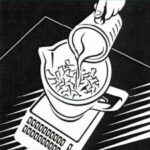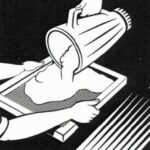Overview
STEM careers
Time
Materials
Per Class:
- Used paper (try different types and colors)
- Blender
- Warm water
- Measuring cup
- 11″ x 14″ framed window screen
- Newspaper
Instructions
 Students learn ways to recycle one of the most common forms of waste—paper products—as they transform little bits of paper into a larger piece of paper that they can then use.
Students learn ways to recycle one of the most common forms of waste—paper products—as they transform little bits of paper into a larger piece of paper that they can then use.
- Take the used paper and rip it up into little pieces until you have about 2 cups.
- Place the pieces in the blender.
- Add 1 cup of warm water, let soak for at least 10 minutes, and then blend until smooth. (Note: soaking for an hour may produce a better result.)

- Hold the screen over the sink or over newspaper and distribute the blended paper evenly over the screen. Press out any excess water.
- After it has dried overnight, use it to write on the next day.
Guiding questions
- How long do you think it will take for this paper to dry out so we can use it?
- Will the paper turn out just like regular writing paper? What makes you think so?
- Does this method of making paper impact the environment in any way?
- Does this method of making paper use any natural resources?
Engineering & science connections
- Recycling is the process of using old products as raw materials to manufacture new products. Recycling can reduce the use of natural resources (including energy for manufacturing) and the waste that goes into landfills. It is a key strategy for sustainability.
- Engineers must be careful to take into account all processes when determining the most sustainable approach to a product. In this paper activity, for example, water was used to create the new paper from the old. An engineer would have to consider whether the benefit of reusing the paper outweighs the extra costs of resources to recycle it. This principle is the basic concept of what is called Life Cycle Analysis, which determines all costs over the course of manufacturing, usage, and end of life of a product.
- You might be surprised by all of the things other than paper that can be made from recycled materials. For example, playground surfaces are often made from car tires, fleece jackets are often made from plastic soda bottles, car parts may be made from tin cans, and some bricks are made with pieces of glass jars.
- Paper can go through the recycling process 5–7 times before it must be permanently discarded. The process of paper recycling causes the natural wood fibers to become shorter and weaker. Aluminum, on the other hand, can be recycled indefinitely.
Thank you to IEEE’s History Center for this activity. Students can learn more about Galvani, Volta, their discoveries, and inventions—and the engineers and inventions that came after them—at the IEEE Virtual Museum: ieee.org/museum.


0 Comments